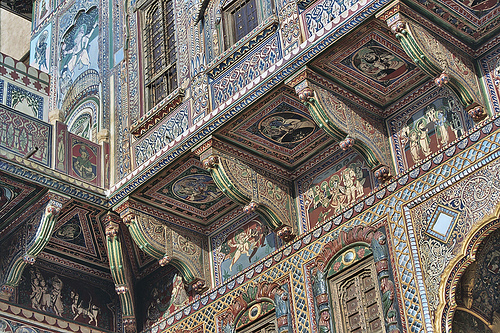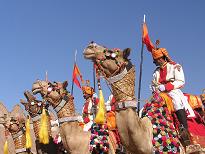Tourist Attractions
in Shekhawati:
The major attraction of the Shekhawati region are the
magnificent havelis. These havelis were built by the Marwaris, the rich merchants of the region,
and display a unique architectural style. These havelis were built to ensure safety and privacy of the women and protection from the heat of the long and harsh summers. The havelis
were painted in the Shekhawati's fresco style, predominantly in the blue,
maroon,
yellow,
green and indigo color and have beautiful wall paintings. The style
of fresco painting is locally known as ala gila. The colours, mixed
into a paste, were applied on to the damp wall with a plaster of lime
paste through beating, burnishing and polishing. The painters and
masons who were commissioned for the task undertook large panels
together and work in teams so that joints in plaster, did not show.
Binding agents such as tempera, gum and camel fat were also used. The
pigments were obtained from iron rich sediments (green, yellow,
ochre), lampblack (black), indigo (blue), stone powder (red), saffron
(orange) and chalk (white). The process of creating the frescos was
tedious. Two layers of clay plaster were provided on the wall and
later the third layer of mortar is provided into which the finely cut
pieces of hessian were added, followed by a coat of plaster using
lime, gravel or brick dust. The final coat consisted of sieved lime
dust made into a paste using sour buttermilk and jaggery. This was the
main surface on which the painters had to draw and fill in colours
while the uppermost layers is still wet. It was then polished with
smooth agate, and dry coconut was rubbed in to seal in the paintings
to ensure that the paintings lasted over centuries, and can be only
damaged by nature. But as most of these paintings are out in the open,
they were more damaged by the men.
The subjects of the Shekhawati frescos (1830 AD - 1900 AD) were based
on the variety of themes, but changed over the period of time.
Floral:
The early works were very simple, used very few colours, and consisted
of floral motifs. Later, floral work was mostly reserved for the
pillars and arches. The floral motifs were commonly used to create
frames and unite a complete section, within which were canvases of
paintings. In the few Muslim havelis, only floral representations of
foliage can be found.
Religious:
Around the main entrance and interior spaces in the havelis consisted
of the mythical and religious images. The main subject was the Indian
religious legends and fables, so that entire canvases could be covered
with the marriage processions of gods, or their great wars with the
demons, or from the Ramayana. The legends of Krishna, and particularly
Ras Leelas, can be seen in the circular ceilings below domes.
Historic:
Historical tales of rulers and scenes of great battles, and portraits
of well known rulers were mainly painted in the chhatris of the wells,
or in the castles of the Rajput feudal chiefs who controlled small
feudatory states in this region.
Secular:
Most of the external walls were painted with the aspects of daily life
that were clearly inspirational and reflect their lifestyles. These
consisted of scenes of processions, of caparisoned elephants, of
celebrated lovers such as Dhola and Maru, and trompe I’oeil paintings
that created a suspension of belief in disbelief. Some of the
delightful representations are the women peeping out of windows, a
camel straddling a small window, or a staircase turning into an
elephant with the balustrade in its trunk.
|
 |
The turn of the 19th century saw the appearance of new motifs,
due to the British Raj’s influence upon the Indian culture. Trains,
cars, balloons, telephones, gramophones, portraits of English men in
hunting attires and their memsahibs, some walking their dog, and
others engaged in needlework and portraits of the haveli owners were
painted all over the walls. By 1930, the Shekhawati frescoes were
degenerated and this resulted in the migration of the Marwari
families. The murals and several examples of beautiful art were
further devastated.
|
Major Places in Shekhawati
The tourists can stay in any of several heritage hotels in Shekhawati that
were once feudal castles. Many of these historic hotels are beautiful
examples of the painted walls of the region. These are the true treasures
of Rajasthan’s open air art galley.
Some of the major places in Shekhawati are Mandawa, Lachhmangarh, Fatehpur, Khatu Shyamji, Shakambari, Jhunjhunu, Sikar, Nawalgarh, Mukundgarh, Chirawa, Dundlod and Pilani.
Mandawa:
Mandawa was founded in the 18th century
and is the heart of the region of Shekhawati. The Chokhani and Ladia havelis and the Saraf havelis are some of the splendid
havelis in Mandawa. A Shiva temple with a rock crystal lingam is also
a worth visiting place. A medieval fort dominates the town of Mandawa. This fort has a painted arched gateway which is adorned with Lord Krishna and his cows. The fort is now converted into a heritage hotel.
|
|
 |
Lachhmangarh:
One of the most imposing forts in the Shekhawati region, Lachhmangarh commands a bird’s eye view of the town modeled to resemble the city plan of Jaipur. Lachhmangarh was founded in the early 19th century by Raja Lachhman Singh of Sikar. The town of Lachhmangarh
has a lot of whimsical subjects painted on its impressive havelis.
Fatehpur:
Fatehpur was founded in the mid 15th century by Fateh Khan, a Kayamkhani nawab. The town is noted for unmatched frescoes and exquisite havelis.
It is one of the richest sources for observing some of the finest art in
the region. Its central location has attracted many wealthy merchants. Havelis offers a combination of the Indian and the western styles. Most famous havelis are the Chamariya and Singhania havelis.
Khatu Shyamji:
Khatu Shyamji is famous for the Shri Shyamji Temple, built in white marble.
Shakambari:
Shakambari is famous for its 7th century temple dedicated to Shakambhari Mata. The town is surrounded by hills on three sides. It is an ideal picnic spot.
Jhunjhunu:
Jhunjhunu, the capital of Shekhawati is one of the largest town of the district. The town was founded by the Kayamkhani Nawabs in the mid 15th century AD and remained under their control until it was taken over by the Rajput ruler Sardul Singh in 1730 AD. The district town has some splendidly painted havelis. Easily accessible of these are those of Nar Singh Das Tibriwal, Ishwar Das-Mohan Das Modi and the Khaitans. The most interesting monument is the Khatri Mahal (the Wind Palace) dating back to around 1760 A.D. with elegant lines. Rani Sati temple is the most famous temple of Jhunjhunu. The Sri Bihariji Temple is noted for its lovely murals.
Sikar:
Sikar was founded in the late 17th century. Sikar was the largest "thikana" (Feudal state) under Jaipur. The fort and temples of Gopinath, Raghunath and Madan Mohan with commendable frescoes are worth visiting. The jubilee Hall, Madho Niwas Kothi, Biwani Haveli, Sodhani Haveli, the Jain temple and a large market are other places of interest.
Nawalgarh:
Nawalgarh was founded in the 18th century. Nawalgarh has the finest of Shekhawati’s frescoes. Its two old forts and palace hotel with garden and fountains along with a host of temples known for their architecture and frescoes add interest to the town. The prominent havelis are of the Poddars, Bhagats and Dangaichs.
Other Places
Mukundgarh:
Mukundgarh is known for its fine havelis. The fort of Mukundgarh is now a heritage hotel.
It is a small settlement which is easy to walk around when viewing fresco
art.
Dundlod:
Dundlod is known for its fort, palace and chhatri frescos. The palace of Dundlod is now running as a heritage hotel. Havelis of the Goenka family are also famous in
Dundlod.
Churu:
Though, Churu is not a part of the Shekhawati region, but it has havelis
which are mainly known for their flamboyant architecture.
Harsh Nath Temple:
Harsh Nath temple, an ancient 10th century temple is situated on the Harsh Nath hills and is about 10 km from Shekhawati town.
Jeen Mata Temple:
Jeen Mata temple is believed to have been built a thousand years ago. The temple is the venue of a colourful fair held twice in a year during ‘Navaratras’.
Chirawa:
Chirawa is a popular trading town between Churu and Loharu. Chirawa is famous for huge havelis. Dalmias, Kakranias and Nemanis Havelis and Poddar wells are worth visiting places in
Chirawa.
Pilani:
Pilani is the home of the Birlas, the leading industrialists of India. It has a large campus of the Birla Institute of Technology and Science (BITS) which is famous all over the world. A beautiful Saraswati Temple, BITS museum, Panchwati and Birla Havelis are various places in Pilani.
Surajgarh and Kajara:
Surajgarh has an impressive 18th century fort, painted temples and havelis. Some beautiful 19th century havelis can be seen in Kajara.
Alsisar and Malsisar:
Alsisar was founded in the late 18th century while Malsisar was founded in the mid 18th century. Both these towns lie at the northern edge of Shekhawati. The angular style of frescoes in various colours make the trip to these town a memorable one.
These two towns are distinguished by the blue and red colour of their
frescos. Beside the fort, the Jhunjhunuwala havelis, a well complex and temples are other interesting places in
Alsisar.
Bissau:
Bissau was founded in the mid 18th century. Bissau has splendid chhatris of Thakurs and finely painted havelis of Khemka, Tibrewals, Jhunjhunuwala and Kedia
that contains high quality of frescos. Bissau also has a fort and the Chhatri of Hammir
Singh, with paintings.
Mehansar:
Mehansar was founded in the mid 18th century. The Sone-Chandi ki Haveli and Raghunath temple with beautiful paintings of the Bikaner School of Art are worth visiting places in
Mehansar. The finest interiors can be found here in a former jeweller’s
showroom and are rich in their use of colours and gilding.
|




